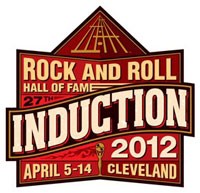
“We are pleased to announce this year’s Hall of Fame inductees, who represent the broad spectrum of artists that define rock and roll,” stated Joel Peresman, President and CEO of the Rock and Roll Hall of Fame Foundation, in the press statement. “We are also thrilled this year to again be partnered with HBO, who presented the Hall of Fame’s 25th Anniversary Concerts.”
And without furthur ado, here is the Class of 2012:
Performer Category:
· Beastie Boys
· Donovan
· Guns N’ Roses
· Laura Nyro
· Red Hot Chili Peppers
· The Small Faces/The Faces
Early Influence:
· Freddie King
Ahmet Ertegun (nonperformer) Award:
· Don Kirshner
The Award for Musical Excellence:
· Cosimo Matassa
· Tom Dowd
· Glyn Johns
Tickets to the ceremony go on sale on December 17, 2011 at 10 a.m. EST. Visit rockhall.com or call (877) 212-8898 for ticket information.
More on the Performers:
BEASTIE BOYS [Courtesy of the Rock and Roll Hall of Fame]:
At different times over the past three decades, the Beastie Boys have been shaven-head punks, hip-hop bad boys, Seventies-funk students, political activists and style icons. Most important: they have had one of the richest, most important careers in hip-hop and rock, introducing rap to a huge new audience and then pushing the frontiers of what a hip-hop group could do. Their 1986 debut album Licensed To Ill – a supremely bratty, hard-punching, pitch-perfect mix of rap and hard rock – was hip-hop’s first number one album, and remains near the top of the Billboard catalog charts to this day. The single “(You Gotta) Fight For Your Right (To Party!),” became a teenage party anthem of the 1980’s; a generation of hip-hop fans memorized hits like “Brass Monkey” and “Paul Revere,” songs which are now part of the rap canon. Their follow-up, 1989’s Paul’s Boutique, was one of the high points of hip-hop’s golden age of sampling, piling hilarious, streetwise rhymes over everything from Loggins & Messina to the Ramones. In the 1990’s, they came full circle musically, picking up their instruments and bringing back hardcore punk and funk into their music repertoire. They recorded three classic albums, Check Your Head, Ill Communication and Hello Nasty, and smash hits like “Sabotage” and “Intergalactic.” Along the way, they’ve kept experimenting with what a hip-hop band can be: becoming the most politically active group of their generation with the Tibetan Freedom Concerts; recording classic videos; putting their fans behind the camera with their film Awesome I F**king Shot That; and recording three new studio albums in the last decade, 2004’s To The Five Boroughs, 2007’s The Mix-Up and 2011’s Hot Sauce Committee Part Two.
DONOVAN [Courtesy of the Rock and Roll Hall of Fame]:
The first British folk troubadour who truly captured the imaginations of early Beatles-era fans on both sides of the Atlantic, Donovan Leitch made the transition from a scruffy blue-jeaned busker into a brocaded hippie traveler on Trans Love Airways. As a folkie on the road with Gypsy Dave, Donovan became a Dylanesque visual presence on the BBC’s Ready Steady Go! starting in 1964, and released several classics: “Catch The Wind,” “Colours,” Buffy Ste.-Marie’s “Universal Soldier,” “To Try For The Sun” and more. That changed in 1966, as he came under the production arm of UK hitmaker Mickie Most, and was signed by Clive Davis to Epic Records in the states. Donovan ignited the psychedelic revolution virtually single-handedly when the iconic single “Sunshine Superman” was released that summer of ’66 (and the LP of the same name, with “Season Of The Witch”). His heady fusion of folk, blues and jazz expanded to include Indian music and the TM (transcendental meditation) movement. Donovan was at the center of the Beatles’ fabled pilgrimage to the Maharishi’s ashram in early ’68 (where, it is said, he taught guitar finger-picking techniques to John and Paul). Donovan’s final Top 40 hit with Most was “Goo Goo Barabajagal (Love Is Hot)” in the summer ’69, backed by the Jeff Beck Group. In the ’70s and ’80s, Donovan continued to record and tour sporadically, including songs for Franco Zeffirelli’s Brother Sun, Sister Moon (finally issued in 2004). During the 1990s, Rick Rubin (after working with Johnny Cash) produced Donovan’s Sutras. The 2008 documentary film, Sunshine Superman: The Journey Of Donovan is an essential overview of his career.
GUNS ‘N ROSES [Courtesy of the Rock and Roll Hall of Fame]:
Guns N’ Roses may have began as just another long-haired band trying to make it on the L.A. Sunset Strip club scene, but when they unleashed their debut LP Appetite For Destruction on the world in 1987 they instantly established themselves as one the most dynamic and explosive hard rock bands in history. In many ways, they became the Rolling Stones for a new generation. While their peers produced glossy songs that romanticized the party atmosphere of mid-1980s Los Angeles, frontman Axl Rose, guitarist Slash, drummer Steven Adler, rhythm guitarist Izzy Stradlin and bassist Duff McKagan wrote about the gritty realities of the scene, most memorably on their masterpiece “Welcome To The Jungle.” The massive single “Sweet Child O’ Mine” showed their gentler side, while “Mr. Brownstone” was a brilliant cautionary tale about the dangers of heroin. In 1991, inspired by Queen and Elton John, they released the highly ambitious Use Your Illusion albums on the same day. Epic singles “November Rain” and “Civil War” proved how quickly the band had evolved in a few short years, and they were soon packing stadiums all across the globe. When the tour wrapped in late 1993, the band paid tribute to their 1970s hard rock, punk and glam heroes by recording an album of covers called The Spaghetti Incident.
LAURA NYRO [Courtesy of the Rock and Roll Hall of Fame]:
Bronx-born singer, songwriter and pianist Laura Nyro (1947-1997) was still a teenager in 1966 when she recorded her debut album, and Peter, Paul & Mary cut “And When I Die.” At age 19, Laura played the 1967 Monterey Pop Festival, which brought her to the attention of first-time manager David Geffen. He led her to Columbia, Laura’s record label for the next 25 years, starting with 1968’s iconic Eli And The Thirteenth Confession. Other artists scored hit after hit with her songs, led by the 5th Dimension’s “Stoned Soul Picnic” and “Sweet Blindness” in 1968 (then “Wedding Bell Blues” in ’69 and “Blowin’ Away” in ’70). Over two consecutive weeks in October 1969, Blood, Sweat & Tears entered the Hot 100 with “And When I Die,” and Three Dog Night followed with “Eli’s Coming.” In 1970-71, Barbra Streisand charted three consecutive times with Laura Nyro songs, “Stoney End,” “Time And Love” and “Flim Flam Man.” Laura’s 1971 LP with Labelle, Gonna Take A Miracle, an entire program of R&B covers, produced in Philadelphia by Gamble & Huff, remains a classic four decades later. Elton John acclaimed her influence to Elvis Costello: “The soul, the passion, the out-and-out audacity of her rhythmic and melody changes was like nothing I’d ever heard before.” Laura’s tragic death of ovarian cancer at age 49 robbed popular music of one of its purest lights.
RED HOT CHILI PEPPERS [Courtesy of the Rock and Roll Hall of Fame]:
Formed in the sin-and-glamour capital of America – Hollywood, California – in 1983, the Red Hot Chili Peppers are one of the most flamboyant, commercially successful and musically influential bands of rock’s last quarter century. Singer Anthony Kiedis, bassist Michael Balzary a/k/a Flea, guitarist Hillel Slovak and drummer Jack Irons were high school pals who combined their passions for Jimi Hendrix, Seventies R&B and hardcore punk with sexual exuberance and local skateboard culture, immediately becoming famous for their outrageous (often near-naked) live shows and incendiary jamming. After Slovak’s death in 1988 and other personnel changes, the Chili Peppers – with guitar prodigy John Frusciante and drummer Chad Smith – broke through with 1991’s BloodSugarSexMagik, a multi-platinum fusion of metal and rap that was pivotal in bringing modern black street culture and music to the Nirvana generation. The Chili Peppers’ hits have run the melodic and emotional gamut from the fierce hip hop of BloodSugar’s “Give It Away” and the 1992 Number Two ballad “Under The Bridge,” one of the best pop songs ever written about the grip of addiction, to the heavy riffing of “Scar Tissue” and the gorgeous melancholy of “Otherside” on 1999’s Californication. The Chili Peppers’ 2006 two-CD set, Stadium Arcadium, went right to Number One, an ambitious collection that added Sixties-pop harmonies, blazing psychedelia and progressive-rock dynamics to their heavy California soul. After their longest hiatus ever, the Chili Peppers returned in the summer of 2011 with a new album, I’m With You (which debuted at Number One in 17 countries), and a new tour that will take them through 2013.
THE SMALL FACES/THE FACES [Courtesy of the Rock and Roll Hall of Fame]:
Founded in London in 1965, the Small Faces were two great bands in one: visionary mods who were creative peers and commercial equals of the Beatles, the Who and the Rolling Stones, then reborn in the early Seventies with a shortened name and a thrilling inventive hard-rock sound. Together, the Small Faces and Faces have been a lasting inspiration on artists like the Black Crowes, the Jam’s Paul Weller, the Replacements and Oasis. Named for their diminutive stature and mod slang for a snappy dresser, bassist Ronnie Lane, organist Ian McLagan, drummer Kenney Jones and singer Steve Marriott recorded an explosive series of U.K. hit singles and classic albums, mostly written by Marriott and Lane, that set the standard for Sixties soul-inflected pop and English psychedelic romanticism. Marriott’s Cockney-Otis Redding wail was a profound influence on heavy-rock singers like Led Zeppelin’s Robert Plant. When Marriott quit in early 1969, Lane, Jones and McLagan recruited singer Rod Stewart and guitarist Ron Wood, both from the Jeff Beck Group. Fusing R&B, country roots and Fifties rock, the Faces made joyful roots music with arena muscle, cutting their own immortal body of work (1972’s “Stay With Me,” Lane’s elegiac gem “Ooh La La”) while conquering America with boozy-brother showmanship. The Faces broke up in 1975 when Stewart went solo full-time and Wood joined the Stones. (Lane died in 1997.) But in their exuberance and pioneering spirit, the Small Faces and the Faces have always been one band: brilliant, unprecedented and as influential as ever.
Source: The Rock and Roll Hall of Fame – December 7, 2011





